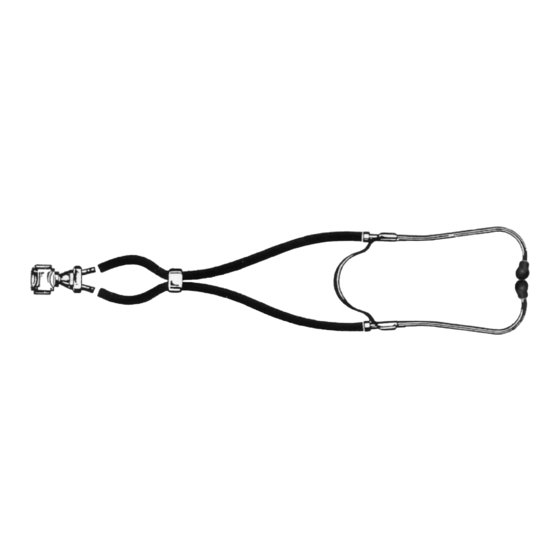
Advertisement
Quick Links
9330-00 rev 16.qxp_Layout 1
Adscope
Thank you for choosing an ADC
to provide unsurpassed acoustic sensitivity, unrivalled durability, and unparalleled comfort.
Every component has been carefully designed to maximize performance.
Device Description and Intended Use
This device is intended for medical diagnostic purposes only. It can be used for listening
to heart, lung and other body sounds as well as for normal auscultation. The device is
not designed, sold, or intended for use except as indicated.
Symbol Definitions
The following symbols are associated with your stethoscope.
LATEX
Not made with natural rubber latex
General Warnings
A warning statement in this manual identifies a condition or practice which, if not
corrected or discontinued immediately, could lead to patient injury, illness, or death.
WARNING: Never use stethoscope without eartips firmly locked in place.
Stethoscope contains small parts which may present a choking hazard.
WARNING:
Cross-contamination of the stethoscope could cause patient infection.
WARNING:
Clean and disinfect stethoscope between uses as described in Care and Maintenance.
Eartips can be swallowed and cause a choking hazard. Ensure all parts
WARNING:
are properly attached and stored.
Stethoscope tubing can be a strangulation hazard. Keep away from children.
WARNING:
NOTE: When first unpacked, your Sprague tubing may experience some kinks from packaging.
This is normal. To uncurl, hang scope for 24 hours at room temperature.
Chestpiece Options
The ADC Sprague design utilizes five different interchangeable chestpiece attachments
(three bells and two diaphragms) to detect a broad frequency range in both pediatric and
adult patients. The chestpiece drum accommodates two different chestpiece attachments
of your choice at one time. Select the type that best suits the intended patient application.
Adult diaphragm assembly - for filtering out lower frequencies
and accenting the higher ranges in adults.
Pediatric diaphragm assembly - for detecting high pitched
murmurs in infants and children.
1 1/4" bell - for detecting low and medium pitched sounds
and murmurs in adults.
1" bell - for detecting low and medium pitched sounds and
murmurs in children.
3/4" bell - for detecting low and medium pitched sounds
and murmurs in infants.
Chestpiece attachments can be affixed by threading clockwise
until tight. To remove, twist in a counterclockwise direction.
(Figure 1)
Selection of the Chestpiece
On ADC Adscope Spragues, the entire chestpiece rotates 180°,
allowing for the selection of one side at a time. Only one side is
operable at a time. ADC's patented valve mechanism eliminates
virtually all acoustic leakage from the inoperable side.
To select the side in operation, hold the chestpiece stem in
one hand and rotate the chestpiece with the other hand until a
click is felt and heard. A light tap on the diaphragm or bell will
help determine which side is in operation as well.
Chestpiece Key
ADC's proprietary chestpiece design and slotted key allows you to tighten the pediatric
or adult assembly as securely as you like (to reduce risk of loss) without fear of being
unable to disassemble the rim in order to replace a worn or
broken diaphragm (a problem that often plagues less costly
Sprague scopes).
Replacing the Diaphragm
To replace a diaphragm, remove the desired assembly by
gripping the assembly firmly and turning counterclockwise.
9/22/23
Sprague
®
Instructions for Use
®
Adscope
®
Stethoscope. Your new stethoscope is designed
9:31 AM
Page 1
(Figure 1)
Adult Diaphragm
Activated
Pediatric Diaphragm
Activated
Advertisement

Summary of Contents for ADC Adscope 641
- Page 1 Activated Chestpiece Key ADC’s proprietary chestpiece design and slotted key allows you to tighten the pediatric or adult assembly as securely as you like (to reduce risk of loss) without fear of being unable to disassemble the rim in order to replace a worn or broken diaphragm (a problem that often plagues less costly Sprague scopes).
- Page 2 Any serious incident that has occurred in relation to this medical device should be reported to ADC and the competent authority of the Member State in which the user and/or patient is established.
















Need help?
Do you have a question about the Adscope 641 and is the answer not in the manual?
Questions and answers